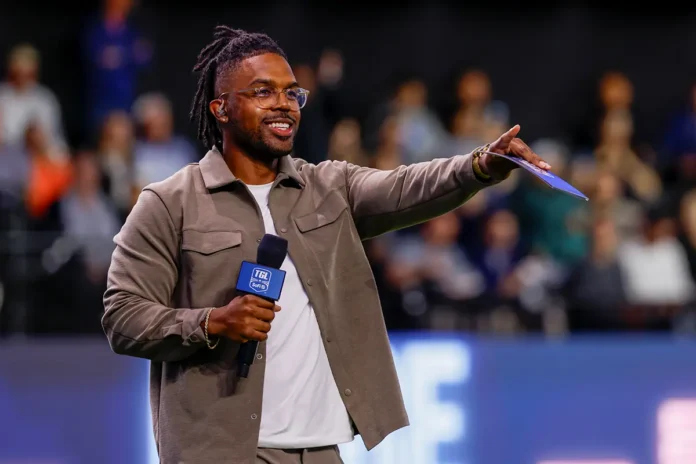For decades, golf media coverage followed a predictable path. Networks like CBS, NBC, and Golf Channel owned the broadcast rights, tournament narratives revolved around star players, and commentary came from a select group of analysts. Coverage was polished, professional, and often exclusive.
But today, the face of golf media is shifting. New media creators—from YouTube stars to TikTok influencers—are bringing fresh voices to the sport. They’ve turned golf into something more accessible, entertaining, and community-driven. Among this wave of creators, one figure stands out: Roger Steele.
Steele’s rise embodies the power of new media in golf and offers a glimpse of how the PGA Tour and the broader golf industry might evolve in the years ahead.
Roger Steele: A New Voice in Golf
Roger Steele didn’t come up through the traditional golf media pipeline. He wasn’t a Tour pro turned broadcaster, nor a long-tenured journalist. Instead, Steele carved his niche through Instagram and YouTube, blending humor, authenticity, and storytelling to make golf feel less intimidating and more welcoming.
What makes Steele unique isn’t just his style—it’s his perspective. He represents a voice that has long been missing in golf: one that is relatable, culturally savvy, and unafraid to challenge the sport’s traditional gatekeepers. Through skits, commentary, and collaborations with brands and players, Steele has captured the attention of fans who might otherwise feel disconnected from golf’s buttoned-up image.
His following has grown rapidly, and with it, his influence. Steele is now working with major golf brands, contributing to media coverage at high-profile events, and even shaping conversations around how golf can become more inclusive. He’s proof that personality and authenticity can drive engagement as effectively as polished broadcasts—sometimes even more so.
From Exclusive to Inclusive
For years, golf media reinforced exclusivity. If you wanted to follow the sport, you needed cable subscriptions and a lot of patience for long-form coverage. This often left casual fans—and especially younger audiences—on the outside looking in.
Steele and other influencers flipped that script. By sharing content on social platforms, they made golf easier to access. Steele’s skits about golf culture, combined with relatable commentary about the challenges of the game, speak directly to the everyday golfer. His message? Golf doesn’t have to be intimidating. It can be fun, social, and accessible to anyone.
That shift—from exclusive to inclusive—is one of the most important transformations in golf media today.
The Power of Personality
Traditional coverage has always focused on the players: Tiger Woods, Rory McIlroy, Scottie Scheffler. While those figures remain central, influencers like Steele show that media personalities themselves can become stars. Fans tune in not only to see great golf but also to connect with someone whose voice, humor, and perspective they trust.
Steele leans into that personal connection. Whether he’s joking about the struggles of hitting fairways or spotlighting underrepresented voices in golf, he’s building relationships with his audience in a way that broadcast coverage can’t replicate.
Redefining Coverage
Steele and other influencers are also redefining what counts as “golf coverage.” It’s not just about who’s leading on Sunday afternoon. It’s about equipment reviews, lifestyle features, community spotlights, and cultural commentary.
Steele, for example, often highlights how golf intersects with culture, fashion, and diversity. His voice resonates with people who may never have considered watching a PGA Tour broadcast—but who see themselves reflected in his content.
For the PGA Tour, that kind of reach is invaluable. Influencers are helping the game reach audiences who might otherwise be missed.
PGA Tour Response: What Comes Next?
The PGA Tour faces a choice: resist these changes or embrace them. Early signs suggest the latter. We’ve seen collaborations with influencers, invitations to pro-ams, and even content partnerships. As golf’s governing bodies wrestle with competition from LIV Golf and shifting fan expectations, working with new media creators may become essential.
Here are four ways the Tour may evolve:
- Collaboration with Influencers
Expect more appearances from figures like Roger Steele in official PGA Tour content. By leveraging their relatability, the Tour can connect with younger, more diverse audiences. - Short-Form Content
Platforms like TikTok and Instagram thrive on clips under a minute. To compete with creators, the PGA Tour will need to invest more heavily in short, snackable content that feels organic rather than over-produced. - Player-Driven Storytelling
Fans want access to the personalities behind the players. Steele’s success shows that authentic, personal storytelling matters. More mic’d-up moments, behind-the-scenes clips, and lifestyle features are likely to follow. - Creative Formats
Influencers have shown that challenges, matches, and entertainment-driven events can attract big audiences. The Tour could experiment with alternative formats alongside traditional 72-hole events.
Risks and Rewards
There are, of course, risks. Purists may argue that influencer-driven content trivializes the sport or distracts from elite competition. There’s also the possibility of tension between professionals and influencers as sponsorship dollars shift.
But the rewards are significant. Influencers like Steele are bringing new fans into the fold, making golf more inclusive, and showing that the game has cultural relevance beyond country clubs and broadcast booths. For a sport that has sometimes struggled to expand its audience, that’s no small achievement.
The Future of Golf Media
Looking forward, golf media will likely become more fragmented but also more vibrant. Traditional broadcasts will remain the cornerstone of major championships, but new media voices will continue to grow in influence.
Roger Steele’s rise is a case study in what’s possible. He’s not just covering golf—he’s reshaping the conversation about what golf is and who it’s for. His success signals that the future of golf media will be built not just on scorecards and stats, but on personality, relatability, and inclusivity.
For the PGA Tour, the path is clear: embrace creators like Steele as partners in growth, not competitors. By blending tradition with innovation, the sport can maintain its heritage while opening its doors wider than ever before.
In the end, golf media is moving from polished exclusivity to authentic inclusivity. And in that story, Roger Steele isn’t just a participant—he’s a pioneer.







